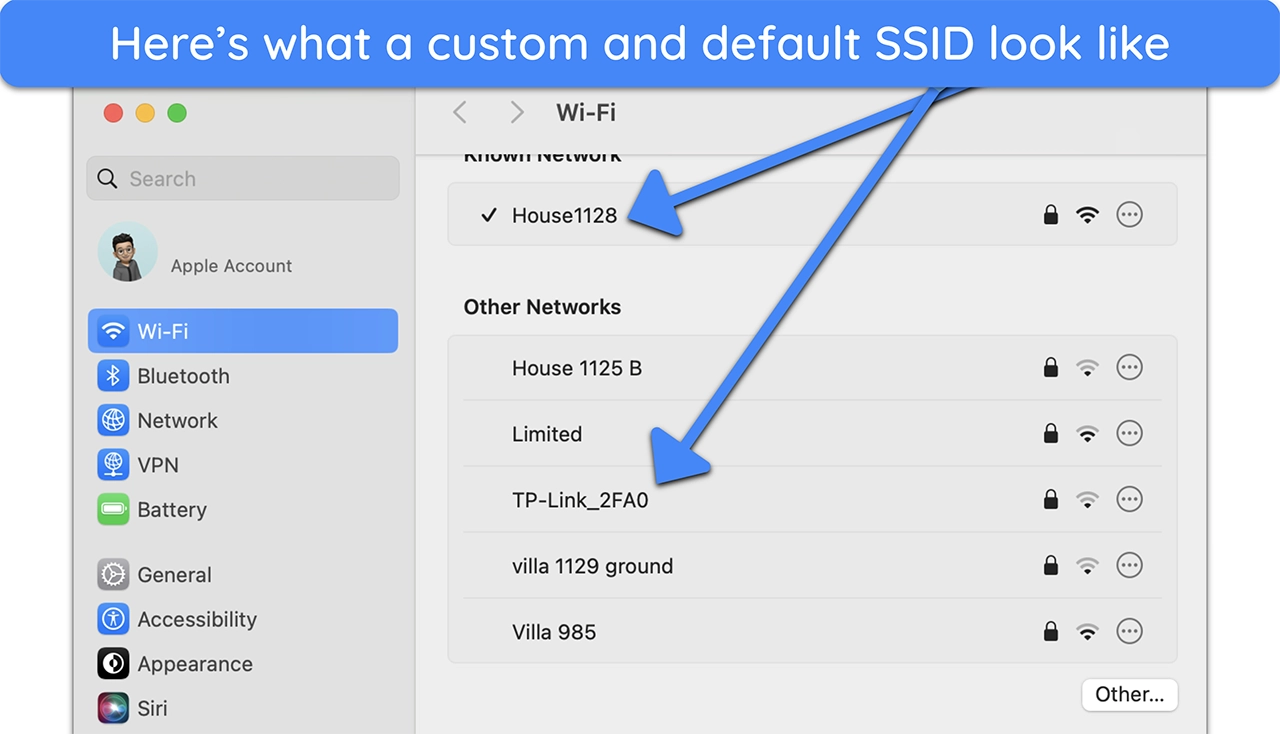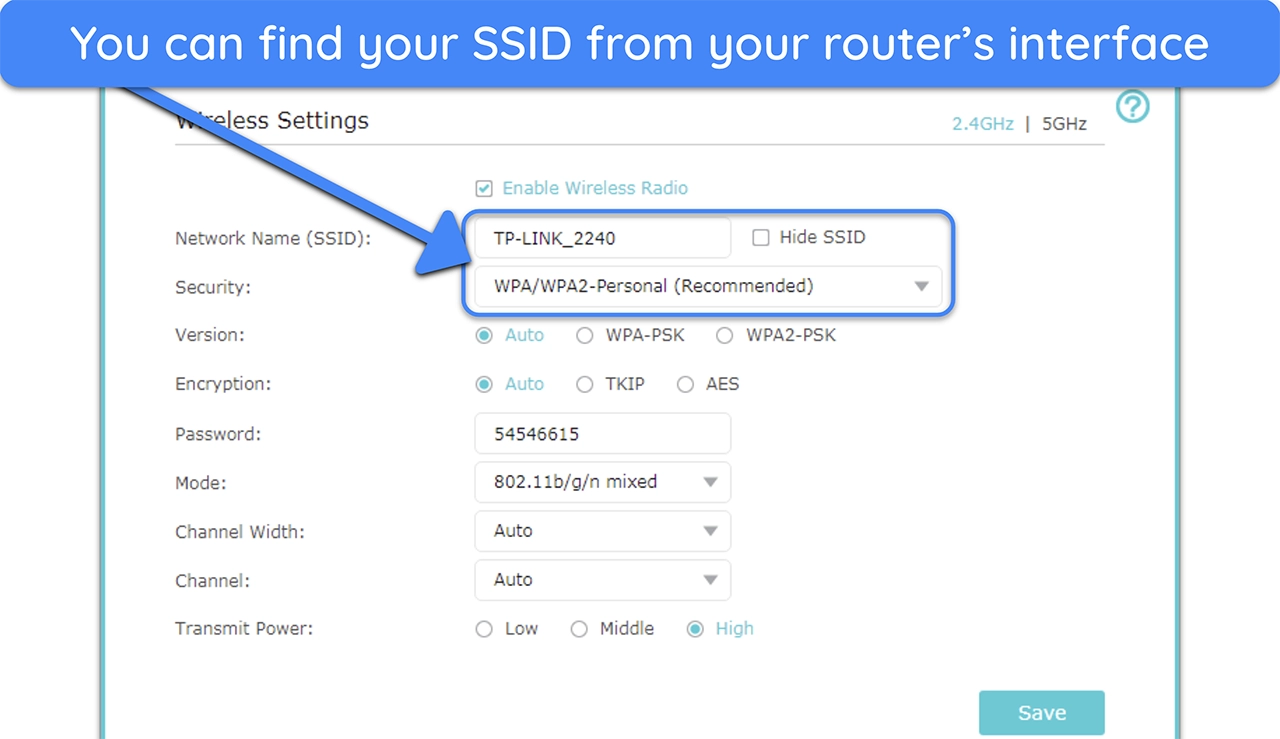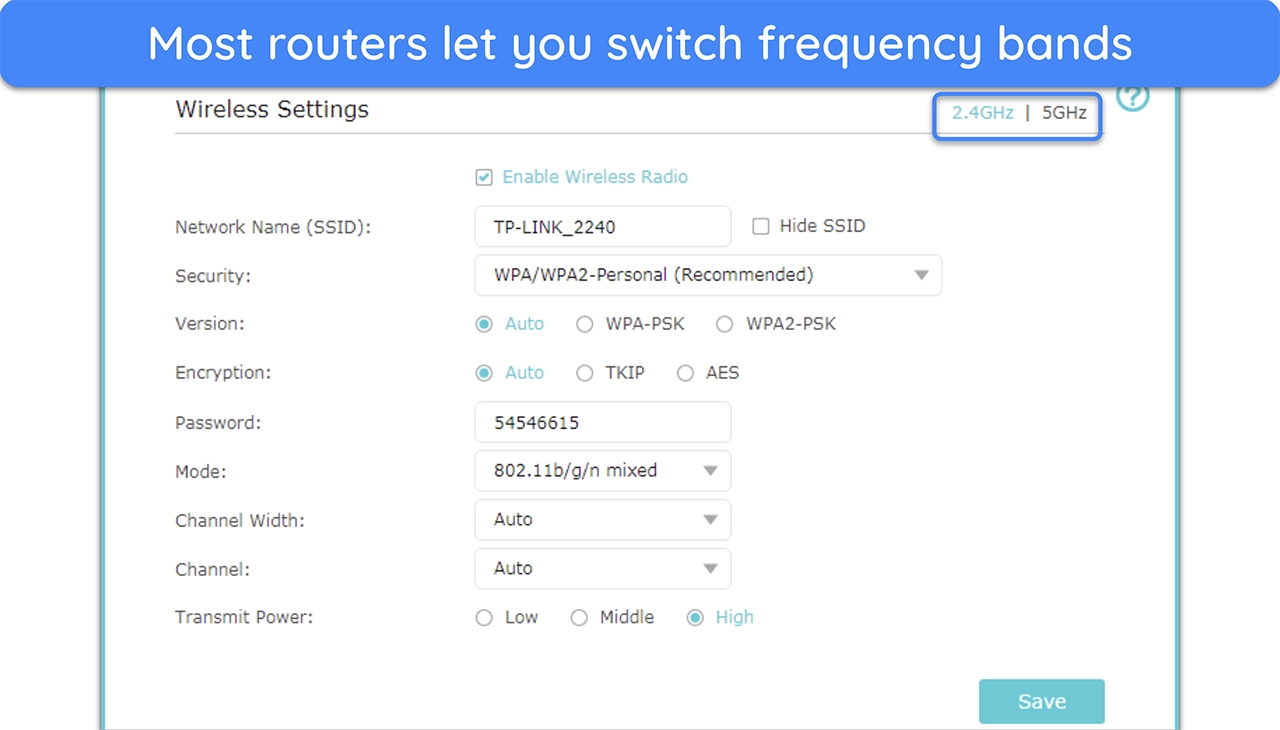What Is SSID? How to Find & Change SSID in 2025 (Full Guide)
A Service Set Identifier or SSID is the unique name of your WiFi network. It helps you find and connect to your network among others nearby. Every WiFi network has one, and a clear SSID name makes it easy to find and connect to your network.
Knowing how to find and change your SSID can improve your network’s security and performance. Updating your SSID helps prevent unauthorized access, reduces signal interference, and keeps your connection stable. In this guide, you’ll learn what an SSID is, how to locate it, and how to change it. Editor’s Note: We value our relationship with our readers, and we strive to earn your trust through transparency and integrity. We are in the same ownership group as some of the industry-leading products reviewed on this site: ExpressVPN, Cyberghost, Private Internet Access, and Intego. However, this does not affect our review process, as we adhere to a strict testing methodology.
Quick Summary: What Is SSID for WiFi & What Is It Used For?
An SSID is your WiFi network’s name. Every router has a default SSID set by its manufacturer. You can find it on the sticker pasted under your router — it looks something like “TP-Link_012050,” “Netgear55,” or “Linksys00737.” However, you can change the SSID to something unique and easily identifiable like “GetyourownWiFi” or your house number.
The SSID’s main purpose is to help you find your Wi-Fi network. However, using the default SSID has two major downsides. First, if you see multiple “TP-Link” or “Linksys” networks, you might not know which one is yours, leading to confusion and possibly connecting to the wrong network.
Second, a default SSID reveals your router’s make and model and hackers can use this information to search for known security flaws in that specific router model and exploit them. This opens the door for attacks like brute-forcing your Wi-Fi password or injecting malware into connected devices.
How to Find Your SSID
If your network is hidden (SSID broadcast is disabled), it won’t appear in the list of available networks. You’ll need to enter the SSID to connect manually. If that’s not the case, it’s easy to find your SSID — here’s how you can do that on different devices:
Router
Most routers have a label with the default SSID and password. Look on the back or bottom of your router for a sticker that contains your SSID or network name and password. If you’ve changed the default SSID, you’ll need to access the router’s settings following these steps:
- Connect your computer to the router using an Ethernet cable.
- Open a web browser and enter the router’s IP address (commonly 192.168.0.1 or 192.168.1.1).
- Log in with your router’s username and password.
- Navigate to the wireless settings to view or change the SSID.
Windows
- Click the WiFi icon in the taskbar at the bottom-right corner.
- A list of available networks will appear.
- Your connected network will be at the top, labeled ‘Connected.’ This is your SSID.
macOS
- Click the WiFi icon in the menu bar at the top right corner.
- A drop-down menu will show available networks.
- The network with a checkmark is your current connection; that’s your SSID.
iOS
- Open the Settings app.
- Tap ‘Wi-Fi.’
- The network with a checkmark is your current connection; that’s your SSID.
Android
- Open ‘Settings.’
- Tap ‘Network & Internet,’ then ‘Wi-Fi.’
- Your connected network will display ‘Connected.’ This is your SSID.
Should You Change Your SSID?
It’s good practice to change your SSID. A custom SSID helps you avoid connection mix-ups, especially in areas with many networks. By renaming it, you’ll easily spot your network without confusing it with a neighbor’s. To keep your network private, avoid personal details like names or addresses in your SSID.
Default SSIDs often reveal details like your router’s brand and model, which can give hackers clues about its security weaknesses. Some routers follow predictable naming patterns for SSIDs, making it easy for attackers to identify routers with specific flaws. By setting a unique SSID, you make your network harder to target.
How to Change Your SSID
It’s easy to change your SSID. The steps below are general and might vary based on your router’s brand and model. Consult your router’s manual or manufacturer’s website for specific instructions.
- Access your router’s settings — Connect your device to the router via WiFi or Ethernet. Open a web browser and enter your router’s IP address.
- Log in to the router interface — Enter the router’s username and password. If unchanged, defaults are often “admin” for both fields.
- Navigate to ‘Wireless Settings’ — Locate sections labeled ‘Wireless,’ ‘WiFi,’ or ‘Wireless Settings.’
- Change the SSID — In the SSID field, enter your desired network name. Avoid using personal information or the router’s specific make and model.
![Screenshot of how to find network SSID from router interface]() You can also hide your SSID from the router interface
You can also hide your SSID from the router interface - Save and apply changes — Click ‘Save’ or ‘Apply’ to confirm. The router may reboot to apply changes. If not, restart it manually.
- Reconnect devices — After the SSID changes, reconnect your devices using the new network name and existing password.
What to Do if Your SSID Isn’t Showing Up
If your WiFi network name (SSID) isn’t appearing, you can follow these steps to troubleshoot:
- Check broadcast settings — Access your router’s settings and ensure “SSID Broadcast” is enabled. If disabled, your network name won’t be visible to devices.
- Restart router and modem — Unplug both devices, wait 30 seconds, then plug them back in. This can resolve temporary glitches that cause the SSID to disappear.
- Ensure WiFi is enabled — Verify that your WiFi is turned on in your device’s settings. Some laptops have a physical switch or function key to enable WiFi.
- Update WiFi drivers — Outdated drivers can cause connectivity issues. Visit your device manufacturer’s website to download and install the latest WiFi drivers.
- Check for interference — Other electronic devices can interfere with WiFi signals. Make sure your router is placed away from such devices and in a central location.
- Verify router’s frequency band — Some devices only support the 2.4GHz band. If your router is set to broadcast only on the 5GHz bank, older devices might not detect it.
![Screenshot of router frequency band]() The 5GHz band is faster than 2.4GHz
The 5GHz band is faster than 2.4GHz - Reset network settings — Navigate to network settings and reset your configuration. This will clear saved networks and settings, potentially resolving the issue.
- Factory reset — If all else fails, try resetting your router to factory settings. This will erase all custom settings, so you’ll have to reconfigure your network afterward.
How to Keep Your Network Safe
Securing your Wi-Fi network helps protect your data and devices from unauthorized access. Follow these steps to maximize your network’s security:
- Change default login credentials — Routers come with default usernames and passwords that are easy for hackers to find. Change these to something unique and complex to prevent unauthorized access.
- Enable strong encryption — Use WPA3 encryption if your router supports it; if not, use WPA2 — both secure data sent over your network.
- Set a strong WiFi password — Create a WiFi password with a mix of uppercase and lowercase letters, numbers, and symbols to make it hard to guess. Avoid using personal information and aim for at least 12 characters.
- Disable WiFi Protected Setup (WPS) — WPS is a convenience feature that allows quick device connections but can be exploited by attackers. Disable WPS adds another layer of security by eliminating this potential entry point.
- Update router firmware — Manufacturers release firmware updates to fix bugs and security flaws. Regularly check for and install updates to ensure your router has the latest protections against threats.
- Disable remote management — Remote management lets you access your router settings from anywhere but can expose your network to outside attacks. For safety, keep this feature off by default.
- Use a guest network — Setting up a separate guest network isolates visitors’ devices from your main network. This prevents potential threats from guest devices from reaching your personal devices and keeps your network organized.
- Enable network firewalls — Your router’s built-in firewall can help block unauthorized traffic, while device-level firewalls add further protection. Together, these firewalls keep your network and devices safe from threats.
- Monitor connected devices — Regularly review the list of devices connected to your network in your router’s settings. Remove any unknown devices to maintain control and ensure only authorized users have access.
- Use a VPN — A VPN encrypts your internet traffic, hiding it from hackers and third parties. Installing a reliable VPN on your router or devices keeps your online activity private and secure.
FAQs on SSID
What is SSID and how do I find mine?
What if other WiFi networks have the same SSID?
How do I choose an SSID name for my WiFi network?
What are the drawbacks of hiding my SSID?
A hidden SSID gives you a false sense of security. If you haven’t hidden it purposely, here’s what you can do if your SSID isn’t showing up. When you hide your SSID, your devices have to broadcast themselves to find the network, which can make them more visible to attackers. This can also cause connection issues.
Hiding your SSID doesn’t add much security since skilled attackers can still find it with special tools. Instead, you’ll get better protection by using strong encryption like WPA3 and setting a secure, unique password.
Can I make my SSID secure?
Can someone on my WiFi network see which websites I’ve visited?
Use a Reliable VPN to Stay Safe on the Internet
Simply put, SSID is the name of your WiFi network. You can change your SSID to something unique but that doesn’t mean you’ll be safe and anonymous on the internet. The main purpose of an SSID is to help you find your home network at a glance — its security comes from how robust of a password you use for your network.








Leave a Comment
Cancel